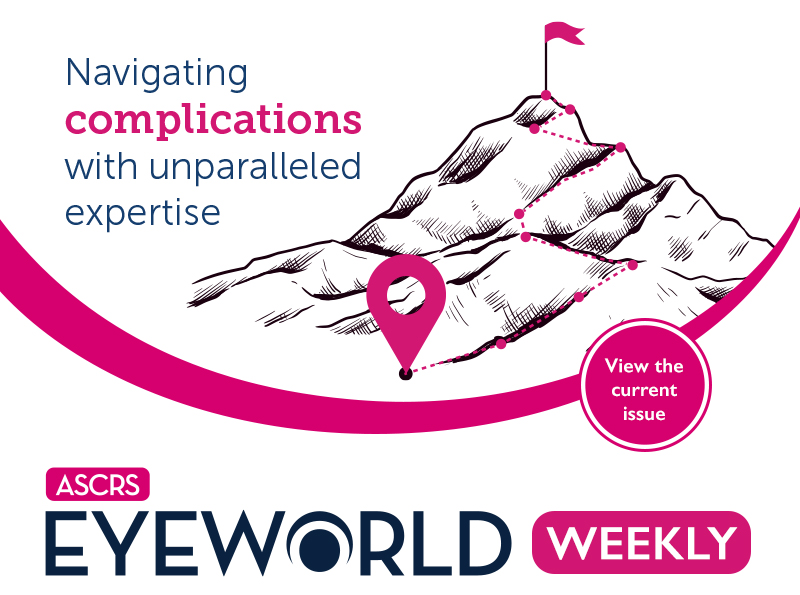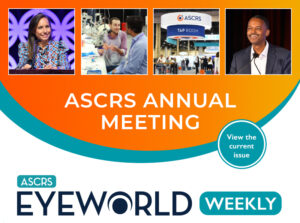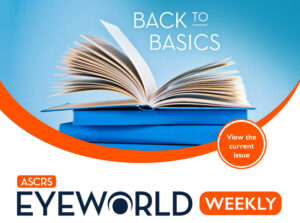
- 3-year efficacy and safety results of gene therapy for wet AMD reported
- Phase 2 trial results of gene therapy for diabetic retinopathy
- Phase 2 program for tracking glaucoma biomarkers begins
- Results from extension study of the first approved treatment for geographic atrophy
- Primary endpoint agreed upon for investigational oral diabetic retinopathy therapy
- ASCRS news and events
November 10, 2023 • Volume 29, Number 45
3-year efficacy and safety results of gene therapy for wet AMD reported
Adverum Biotechnologies reported the 3-year efficacy and safety results from its extension study of ixoberogene soroparvovec (Ixo-ved, previously ADVM-022). The clinical-stage gene therapy, according to the company, carries an aflibercept coding sequence and can be administered as a one-time intravitreal injection in the physician’s office and is intended to reduce anti-VEGF treatment burden while improving vision for patients with wet AMD. The extension study showed that patients continued to experience maintenance of vision, durability of anatomical improvements, and a sustained reduction in anti-VEGF injections. More specifically, anti-VEGF injections were reduced by 84% with 53% of patients being injection-free at year 3. The researchers observed elevated aflibercept protein levels up to 4.5 years after administration of the gene therapy.
Phase 2 trial results of gene therapy for diabetic retinopathy
REGENXBIO announced results from its Phase 2 trial evaluating ABBV-RGX-314 for treatment of diabetic retinopathy when patients do not have central diabetic macular edema. According to the company’s press release, the treatment continues to be well tolerated in the 50 patients who have received doses at level 1 and level 2 (no drug-related serious adverse events). Dose level 2 was shown to prevent disease progression and reduce vision-threatening events in patients with non-proliferative diabetic retinopathy at 1 year. Just over 70% of patients achieved improvement in diabetic retinopathy severity scale compared to 25% in the control group, and vision-threatening events were 89% less in the study group compared to the control group. The company stated that this research is moving forward with two separate administration methods: one through standard subretinal delivery and the other using Clearside Biomedical’s SCS Microinjector to deliver the gene therapy to the suprachoroidal space.
Phase 2 program for tracking glaucoma biomarkers begins
Amydis began a Phase 2 clinical program for AMDX-2011P, a retinal tracer that detects amyloid-beta in glaucoma patients. According to the company’s press release, this technology would be an in-vivo diagnostic test that could add better understanding of the diseases’ pathogenesis. The company stated that this test could “greatly increase the capture rate of glaucoma while improving clinical management through earlier intervention and, potentially, facilitation of amyloid beta targeted neuroprotective therapies.” Proof-of-concept studies have been conducted in post-mortem eyes of glaucoma patients (though not yet healthy patients). The Phase 2 study will be an open-label, blinded endpoint assessment study conducted with patients who have primary open angle glaucoma.
Results from extension study of the first approved treatment for geographic atrophy
Apellis Pharmaceuticals announced data from its extension study that showed increasing treatment effects 3 years after SYFOVRE (pegcetacoplan) injection for treatment of geographic atrophy secondary to AMD. According to the company’s press release, a year-over-year treatment effect was observed with a more than 40% reduction in nonsubfoveal lesion growth by year 3. SYFOVRE can be dosed monthly or every other month.
Primary endpoint agreed upon for investigational oral diabetic retinopathy therapy
Ocuphire Pharma announced that it and the FDA have agreed upon a primary endpoint for Phase 3 pivotal trials for APX3330, which is an investigational oral therapy for treatment of diabetic retinopathy. According to the company’s press release, this endpoint will be slowing or preventing progression of diabetic retinopathy as measured by percentage of subjects with 3 or more step worsening on a binocular diabetic retinopathy severity scale. The company stated that it will submit a Special Protocol Assessment for the clinical trial protocol and statistical analysis. APX3330 is described as a “first-in-class, small molecule, oral inhibitor of the transcription factor regulator Ref-1 (reduction-oxidation effector factor-1)” that “blocks the downstream pathways regulated by Ref-1–which involve angiogenesis (VEGF) and inflammation (NFkB)—to decrease abnormal activation of both angiogenesis and inflammatory pathways that are implicated across several ocular diseases, including DR, DME, and age-related macular degeneration (AMD).”
ASCRS news and events
- ASCRS Grand Rounds: The latest episode of ASCRS Grand Rounds, presented by residents and faculty at Tulane University School of Medicine, is posted. Watch it online.
- ASCRS Annual Meeting: There is an open call for submissions for case videos for four sessions at the 2024 ASCRS Annual Meeting. Click here to learn more about each of these opportunities and how to submit.
- A Taste of ASCRS: This nine-section CME program is available on demand. Learn more about the program.
Research highlights
- A systematic review and meta-analysis published in the Journal of Cataract & Refractive Surgery evaluated the safety and efficacy of immediately sequential bilateral cataract surgery (ISBCS) compared to traditional, delayed sequential bilateral cataract surgery (DSBCS). Thirteen articles met the authors’ criteria for inclusion in the analysis for more than 11 million participants and 18 million eyes. The authors reported no statistically significant difference between ISBCS and DSBCS in all postoperative outcomes they evaluated. They did note a higher risk of PCR in the ISBCS group in analysis of nonrandomized studies. They concluded that “the ISBCS approach has an acceptable safety-efficacy profile, comparable with DSBCS. Future investigations are warranted, with a focus on the analysis of risk factors for surgical complications, patient-reported outcome-measures, and cost effectiveness.”
- The long-term safety and efficacy of perfluorohexyloctane (MIEBO, Bausch + Lomb) for the treatment of dry eye was the subject of a Phase 3, multicenter, single-arm, open-label extension study. The study had 208 patients use one drop of the product 4 times a day for 52 weeks in both eyes. According to the paper published in the journal Cornea, 13.9% of patients had 1 or more adverse ocular event(s); most were mild or moderate. The most common was vitreous detachment (1.9%), allergic conjunctivitis (1.4%), blurred vision (1.4%), and increased lacrimation (1.4%). Improvements in corneal fluorescein staining and VAS dryness scores were continued through the extension study, and patients in the original study who were on saline as a control were switched to perfluorohexyloctane and showed improvements in these metrics as well. The authors concluded that the treatment was safe and well tolerated over the 52 week period.
Product news
- Lumenis launched OptiPLUS, a dual-frequency radiofrequency device as a complement to its OptiLIGHT technology that targets the meibomian glands for treatment of dry eye disease.
- TopCon launched TEMPO Perimeter, a visual field testing device that’s functional in ambient light, which the company states is 39% faster than Standard Automated Perimetry.
This issue of EyeWorld Weekly was edited by Stacy Jablonski, Liz Hillman, and Ellen Stodola.
EyeWorld Weekly (ISSN 1089-0319), a digital publication of the American Society of Cataract and Refractive Surgery (ASCRS), is published every Friday, distributed by email, and posted live on Friday.
Medical Editors: Sumit “Sam” Garg, MD, Chief Medical Editor, Mitchell Weikert, MD, Cataract Editor, Karolinne Rocha, MD, PhD, Refractive Editor, Julie Schallhorn, MD, Cornea Editor, Manjool Shah, MD, Glaucoma Editor
For sponsorship opportunities or membership information, contact: ASCRS • 12587 Fair Lakes Circle • Suite 348 • Fairfax, VA 22033 • Phone: 703-591-2220 • Fax: 703-591-0614 • Email: ascrs@ascrs.org
Mention of products or services in EyeWorld Weekly does not constitute an endorsement by ASCRS.
Click here to view our Legal Notice.
Copyright 2023, EyeWorld News Service. All rights reserved.



